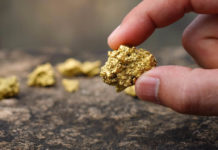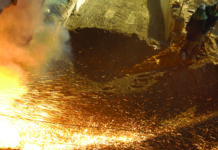
[miningmx.com] — COMPARISONS between the health of South Africa’s
mining sector and some of the world’s booming jurisdictions, like Australia, don’t tell
the full story of the local industry’s performance.
We often hear from experts how South Africa’s mining industry is on a downward
track and that the country has missed out on the previous run in commodities prior
to the financial crisis.
I don’t disagree with the fact that mining is increasingly making a smaller
contribution to South Africa’s overall GDP, or that locations such as Australia and
South America are becoming more attractive. But the fortunes of the various
jurisdictions cannot simply be lined up against one another.
PwC’s Annual Review of Global Trends in the Mining Industry, released last week,
provides an intriguing perspective.
The report combines the financial statements and production figures of the 40
largest listed mining groups.
What is striking these days is that whenever mining is discussed from a global
perspective, the three main commodities in focus are iron ore, coal and copper – the
basic components for the industrial revolution and urbanisation taking place in China
and India.
South Africa has never been a world leader in any of these resources.
The major targets for mining investment in 2011 remained South America and
Australia, accounting for more than half of the world’s capital expenditure in 2011,
PwC says. This makes sense, because these two continents are the world’s mecca for
iron ore (Australia and South America), copper (South America) and coal (Australia).
Coal, iron ore and copper projects have all attracted about 20% of the year’s capital
expenditure; gold projects were in fourth spot, with about 15% of the total.
Africa as a whole, received about 15% of the capital expenditure for all resources,
PwC’s analysis shows.
Profit margins sketch the same picture. In 2011, iron ore yielded a margin of about
65%. For copper, the figure was close to 40%, and for coal just under 30%, PwC
says. For platinum, it was virtually nil.
Also, the mining sector throughout the world is treading water as far as production is
concerned.
The copper price has increased by 240% since 2005, but production by only 10%.
The price of iron ore has risen 429%, but production is up only 30%. Similarly, the
price of thermal coal climbed 245%, but production by only 20%. The gold price has
increased by 350% since 2005, but international gold production went up by only
11%.
The PwC report uses the same base year for its mineral production index as
Statistics South Africa (SSA). According to SSA, South African mining output shrank
by 8.6% from 2005 to 2011.
This fall is the result of the closure of many mined-out gold mines – and a similar
scenario exists for diamonds. Gold and diamonds aside, South Africa’s mining sector
still grew by only a relatively modest 2.3% since 2005.
South Africa’s status as a resources treasure chest rests largely on the Bushveld
complex, which contains the lion’s share of the world’s known platinum reserves.
Citibank’s well-known guess that South Africa has the world’s most valuable mineral
reserves rests almost exclusively on the massive platinum reserves.
The country’s platinum production in 2011 and 2010 was about 5% lower than in
2005. Anyone who believes platinum production should have grown is overlooking
the huge surplus in the platinum market. South Africa has to, in fact, cut its
platinum production to ensure viable price levels.
Gold, platinum and diamonds are not the resources in which the global mining
industry is outperforming South Africa.
Also, the production of steel-related resources, which are mined on a smaller scale
in South Africa, has actually grown enormously since 2005. Iron production in 2011
was about 47% higher than as in 2005. The production levels of the two other large-
scale steel inputs mined here, chrome ore and manganese ore, were 43% and 89%
higher respectively.
The sector in which in South Africa is truly falling noticeably short is coal. Though
the country’s coal is mostly not of export quality and is largely used in Eskom’s
power stations, the stagnation in production is still significant and disappointing. In
2011, we mined only 5% more coal than in 2005.
But even if local iron ore, manganese ore and chrome ore production had doubled
over this time, it hardly would have compensated for the fall in gold production as
far as the GDP and job creation were concerned.
– Sake24











